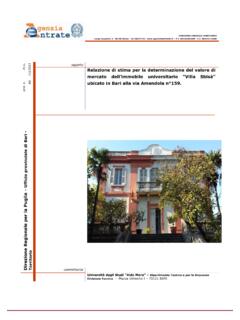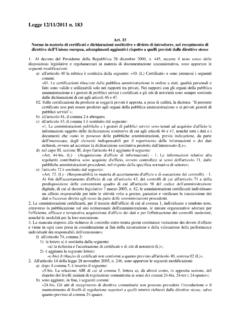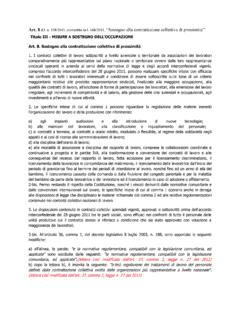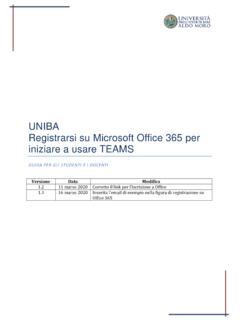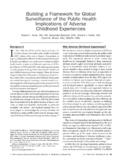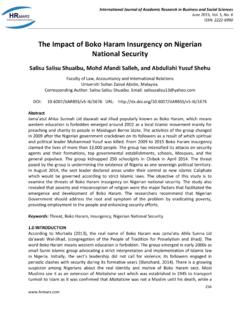Transcription of Guidelines for applying Porter's five forces framework: a ...
1 Competitiveness ReviewGuidelines for applying Porter's five forces framework : a set of industry analysistemplatesMichael E. DobbsArticle information:To cite this document:Michael E. Dobbs , (2014)," Guidelines for applying Porter's five forces framework : a set of industryanalysis templates ", Competitiveness Review, Vol. 24 Iss 1 pp. 32 - 45 Permanent link to this document: on: 26 February 2017, At: 03:30 (PT)References: this document contains references to 31 other copy this document: fulltext of this document has been downloaded 55301 times since 2014*Users who downloaded this article also downloaded:(2007),"An analysis of the environment and competitive dynamics of management education", Journal ofManagement Development, Vol.
2 26 Iss 1 pp. 9-21 (2003),"Customer loyalty and customer loyalty programs", Journal of Consumer Marketing, Vol. 20 Iss 4 to this document was granted through an Emerald subscription provided by All users groupFor AuthorsIf you would like to write for this, or any other Emerald publication, then please use our Emerald forAuthors service information about how to choose which publication to write for and submission guidelinesare available for all. Please visit for more Emerald is a global publisher linking research and practice to the benefit of society. The companymanages a portfolio of more than 290 journals and over 2,350 books and book series volumes, as well asproviding an extensive range of online products and additional customer resources and is both COUNTER 4 and TRANSFER compliant.
3 The organization is a partner of the Committeeon Publication Ethics (COPE) and also works with Portico and the LOCKSS initiative for digital archivepreservation.*Related content and download information correct at time of by At 03:30 26 February 2017 (PT) Guidelines for applying Porter sfive forces framework : a setof industry analysis templatesMichael E. DobbsDepartment of Management, Eastern Illinois University,Charleston, Illinois, USAA bstractPurpose The purpose of this paper is to provide practitioners and students a practical yetcomprehensive set of templates for applying Michael Porter s five forces framework for Based on experiences with practicing managers, small businessowners, industry analysts, academics, and students, a set of industry analysis templates thatsystematically guides an analyst through a comprehensive assessment of the five forces is presentedwith the following.
4 Copies of the templates themselves, descriptions of their structure and use, anexample of a completed template (spectator sports industry), and a discussion of possiblemodifications and The industry analysis templates described in this paper retain the comprehensiveness ofPorter s framework but in a format much more student/manager-oriented using graphics, visual cues,a uniform structure, and straightforward descriptions of concepts. Template users show evidence ofdeeper strategic insights and have a sophisticated tool for future implications Managers, analysts, students, and others wanting robust industry analysisare provided with a comprehensive, structured, and practical set of templates to use in assessing anindustry using the five forces Leading strategic management texts and other sources provide nocomprehensive, systematic, and robust format for conducting a five forces analysis of an set of industry analysis templates described in this paper provides a visually compelling.
5 User-friendly format that can assist those analyzing industries gain important strategic insights notonly into industry drivers, but also important competitive advantages for individual management, Industry analysis, Five forces framework , Sport industry analysis,Teaching tools, TemplatesPaper typeConceptual paperIn 1980, Michael Porter publishedCompetitive Strategy, a work that shaped thethinking of a generation of academics and managers (Crowther, 2008; Magretta, 2012).Included in that foundational text (the first chapter, in fact) was Porter s description of five forces that shape the structure of all industries and in large part establish therules of competition and the root causes of profitability within an industry (Porter,2008).
6 The five forces are the threats posed by competitive rivalry, powerful buyers,powerful suppliers, potential new entrants, and substitute products. According toPorter (1980, p. 3), the collective strength of the forces determines the ultimate profitpotential in the industry . But of more interest to Porter, as emphasized in his update ofthe five forces in 2008, is the potential to use the five forces framework to understandstrategic implications for individual firms within an current issue and full text archive of this journal is available ReviewVol. 24 No. 1, 2014pp. 32-45qEmerald Group Publishing Limited1059-5422 DOI ,132 Downloaded by At 03:30 26 February 2017 (PT)Challenges in using the five forcesThe practical application of the five forces framework , however, has been morechallenging.
7 Porter (2008) himself admits as much and describes common misapplicationsof the framework . Magretta (2012), Allio and Fahey (2012) and Leeet al.(2012) alsodescribe managerial difficulties. While working with practicing managers, small businessowners, MBA and undergraduate business students, and other academics, I havewitnessed many of the same things. The following challenges in using the five forcesframework are taken from Porter (2008), Magretta (2012) and my own of depthMany people only understand the five forces framework and its use in an inordinatelyshallow way. At best, this leads to incomplete, inaccurate, and unhelpful analysis.
8 Atworst, it can lead to misanalysis, poor decision making, and disastrous organizationaloutcomes. Those of us in academia bear a good deal of the blame when it comes to a lackof depth in teaching students about the concepts and usage of the five forces begins with textbook coverage. I surveyed ten leading (Napshin, 2010) strategicmanagement textbooks and catalogued the coverage of the five forces in each (Table I).The number of pages devoted to the five forces framework ranges from four to 21 two of the textbooks provide in-depth descriptions, explanations, and applications(Thompsonet al., 2012; Barney, 2011). Most textbooks summarize the basic concepts,reprint or adapt Porter s graphical depiction of the framework , and provide examplesfrom various industries.
9 Two other textbooks (Wheelen and Hunger, 2012; David, 2011)provide only four pages of coverage, diluting the power and potential value of theframework considerably. Unless students read one of the two textbooks with in-depthcoverage of the five forces and have an instructor who can comprehensively andeffectively explain the framework , most will grasp only a superficial familiarity with fiveAuthor(s) of five forcescoverageBarneyGaining and Sustaining CompetitiveAdvantage4201121 DavidStrategic Management: Concepts andCases1320114 Dess, Lumpkin, Eisner andMcNamaraStrategic Management: Text andCases6201211 Hill and JonesStrategic Management: AnIntegrated Approach10201311 Hitt, Ireland and HoskissonStrategic Management:Competitiveness & Globalization1020138 MarcusManagement Strategy.
10 AchievingSustained Competitive Advantage220118 Pearce and RobinsonStrategic Management: Planning forDomestic and Global Competition1320137 RothaermelStrategic Management: Concepts andCases120138 Thompson, Peteraf,Gamble and StricklandCrafting and Executing Strategy: TheQuest for Competitive Advantage18201218 Wheelen and HungerStrategic Management and BusinessPolicy: Toward Global Sustainability1320124 Table forces coveragein leading strategicmanagement textbooksPorter s fiveforcesframework33 Downloaded by At 03:30 26 February 2017 (PT) forces terminology. When these students graduate and become managers, smallbusiness owners, and/or entrepreneurs, any industry analysis using the five forcesframework will be crippled by its lack of depth.
